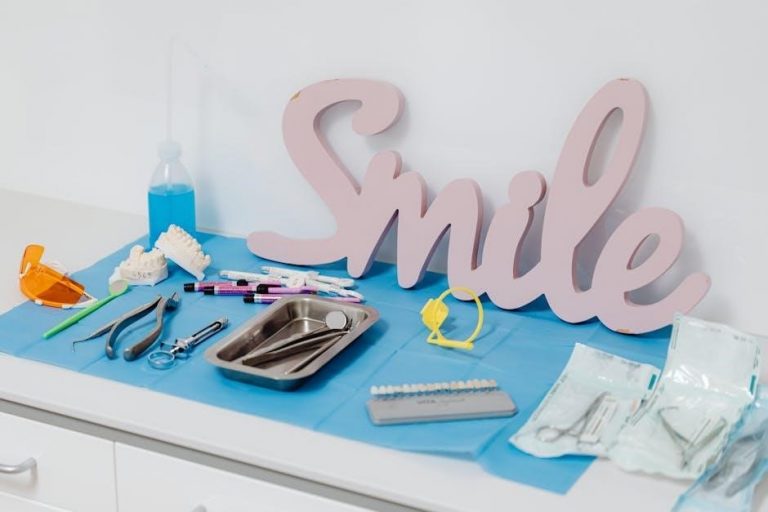A dental assistant tray setup guide outlines the essential steps for organizing instruments and supplies efficiently․ Proper setup ensures smooth procedures, reducing delays and enhancing patient care․ Key elements include a preset tray system, clear plastic barriers for infection control, and basic supplies like topical anesthetics․ This guide helps dental assistants prepare accurately for various procedures, ensuring all necessary tools are readily available․ It emphasizes organization, sterilization, and patient communication, making it a vital resource for effective dental practice․
1․1 Importance of Proper Tray Setup
Proper tray setup is crucial for efficiency and infection control in dental procedures․ A well-organized tray ensures all necessary instruments are readily available, reducing delays and allowing the dental team to focus on patient care․ Correct setup prevents cross-contamination and maintains a sterile environment, adhering to safety protocols․ It also enhances professionalism, as a neatly prepared tray reflects attention to detail․ By streamlining the process, proper tray setup minimizes distractions and ensures the procedure flows smoothly, ultimately improving patient outcomes and satisfaction․
1․2 Overview of Dental Assistant Responsibilities
Dental assistants play a vital role in ensuring efficient workflow by preparing and organizing procedure trays․ Their responsibilities include selecting appropriate instruments, maintaining infection control protocols, and arranging supplies for specific treatments․ They also assist during procedures, handle patient communication, and manage post-procedure cleanup․ Proper tray setup is a cornerstone of their duties, requiring attention to detail and knowledge of procedure requirements․ By efficiently preparing trays, dental assistants contribute to seamless operations, allowing dentists to focus on patient care․ Their organizational skills and adherence to protocols are essential for maintaining a safe and efficient clinical environment․
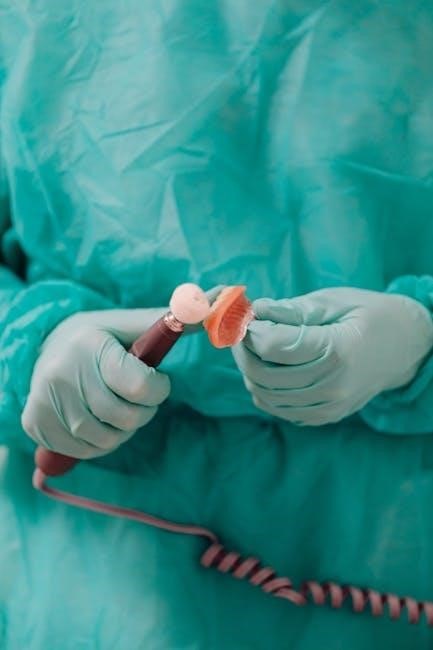
Basic Tray Setup
The basic tray setup involves organizing essential instruments and supplies for common procedures, ensuring efficiency and compliance with infection control standards․ This foundational setup streamlines dental operations․
2․1 Essential Instruments for a Basic Tray
The basic tray setup includes essential instruments like the periodontal probe, dental mirror, explorer, cotton pliers, and 2×2 gauzes․ These tools are fundamental for diagnosing and preparing for procedures․ The periodontal probe measures pocket depths, while the dental mirror provides visibility․ The explorer detects decay, and cotton pliers handle materials like gauze or cotton rolls․ Organizing these instruments efficiently ensures quick access during procedures, enhancing workflow and patient care․ Proper arrangement also reduces contamination risks and maintains a sterile environment, aligning with infection control protocols․ These instruments form the backbone of any dental setup, supporting both diagnostic and operative tasks effectively․
2․2 Supplies Needed for Initial Setup
Essential supplies for the basic tray setup include topical anesthetic, air-water syringe, cotton rolls, 2×2 gauzes, and disposable tray barriers․ These items ensure proper patient preparation and infection control․ Topical anesthetic numbs the area, while cotton rolls and gauzes manage moisture and bleeding․ The air-water syringe aids in rinsing and drying the area․ Clear plastic tray barriers prevent cross-contamination and maintain a sterile environment․ Organizing these supplies efficiently streamlines the procedure, allowing the dental assistant to focus on patient care and procedural efficiency․ These basics are critical for a smooth and safe dental setup process․
2․3 Step-by-Step Basic Tray Assembly
Begin by placing a clear plastic barrier on the tray to prevent contamination․ Next, add essential instruments like the periodontal probe, cotton rolls, and suction devices․ Position the air-water syringe and topical anesthetic in easy-to-reach locations․ Arrange gauzes and disposable items like saliva ejectors on one side․ Ensure all supplies are organized logically for efficient access․ Finally, add patient-specific items, such as local anesthetic syringes, if required․ This systematic approach ensures the tray is prepared for quick and effective use during procedures, maintaining sterility and operational flow․
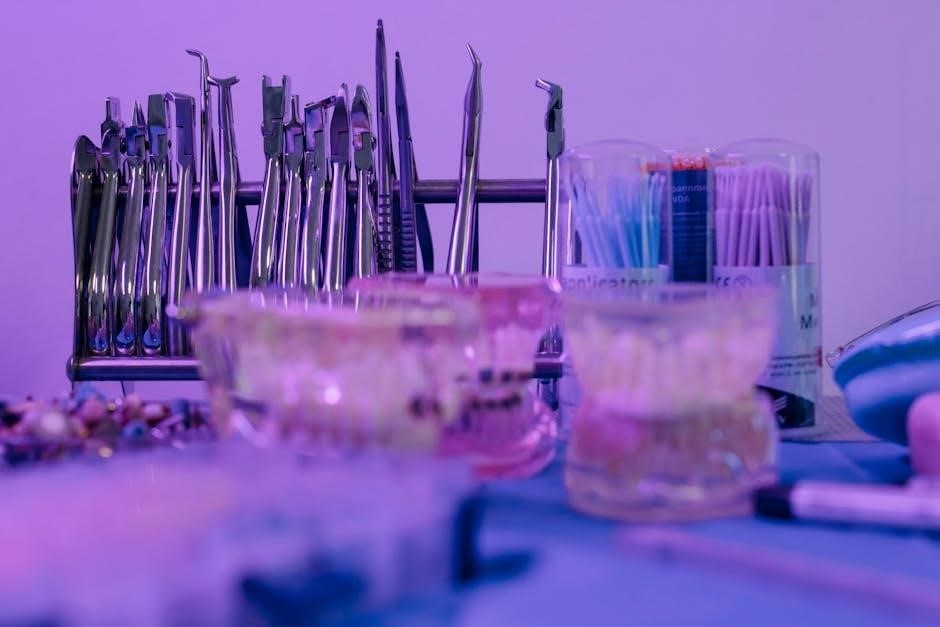
Procedure-Specific Tray Setup
Procedure-specific trays are tailored for treatments like composite fillings, extractions, or root canals․ Each setup includes instruments unique to the procedure, ensuring efficiency and preparedness for the dentist․
3․1 Composite Filling Tray Setup
The composite filling tray setup includes essential instruments like composite resin, curing light, and polishing burs․ The dental assistant ensures all materials are organized and within reach․ Key items include a mixing bowl for composite materials, a light-curing unit, and various polishing tools․ Proper setup streamlines the procedure, allowing the dentist to focus on placing and shaping the filling efficiently․ The assistant must also prepare additional supplies, such as cotton rolls and suction devices, to maintain a clean and dry working area during the procedure․
3․2 Extraction Tray Setup
An extraction tray setup includes instruments tailored for tooth removal procedures․ Essential items are surgical telescopes, extraction forceps, elevators, and suction devices․ The dental assistant ensures forceps are matched to the tooth type and elevators are sterilized․ Gauze pads and local anesthetic syringes are also included․ Instruments are arranged logically for easy access, with critical tools like forceps placed at the front․ Tray barriers are used for infection control, and all items are sterilized beforehand․ This organized setup helps the dentist perform the extraction efficiently and safely, minimizing complications and ensuring patient comfort․
3․3 Root Canal Tray Setup
A root canal tray setup requires specific instruments for endodontic procedures․ Essential items include endodontic files (K-files and H-files), reamers, explorers, and gutta-percha․ Local anesthetic, Root Canal Sealer, and cotton pellets are also needed․ The dental assistant ensures all instruments are sterilized and arranged logically․ The setup includes a mixing bowl for sealer and a container for waste․ Instruments are organized by size and type for easy access, allowing the dentist to work efficiently․ Proper tray preparation is critical to ensure a smooth and successful root canal procedure, maintaining sterility and organization throughout․
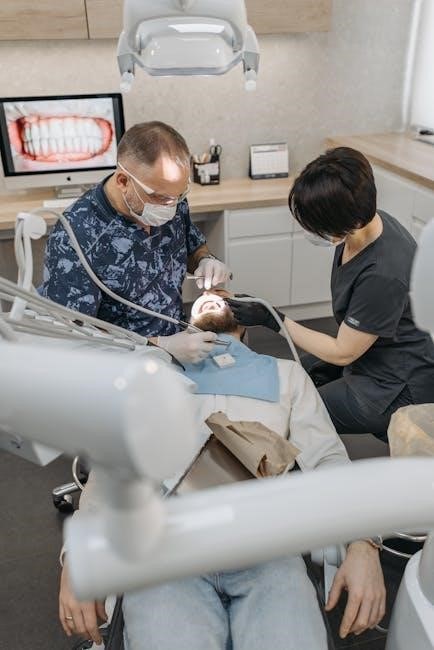
Sterilization and Infection Control
Sterilization is crucial for infection control․ Instruments must be autoclaved before setup, and disposable barriers like plastic tray covers should be used․ This ensures a safe environment for procedures․
4․1 Sterilizing Instruments Before Setup
Sterilizing instruments before setup is critical to prevent infection and ensure patient safety․ Instruments are typically autoclaved at high temperatures to eliminate pathogens․ Chemical disinfection may also be used for heat-sensitive items․ All instruments must be cleaned thoroughly before sterilization to remove debris․ Disposable items, like needles, are used once and discarded․ Proper sterilization protocols must be followed strictly to maintain asepsis․ Dental assistants play a key role in ensuring instruments are sterilized correctly, organized, and ready for use․ This step is essential for maintaining infection control standards in dental procedures․
4․2 Using Tray Barriers for Infection Control
Tray barriers are essential for infection control in dental settings․ Clear plastic tray barriers are placed over trays to prevent contamination․ They are single-use and disposed of after each patient․ Barriers should be applied before adding instruments to the tray․ This ensures all items remain sterile and ready for use․ Additional barriers, such as pouches for individual instruments, may also be used․ Properly using tray barriers helps maintain asepsis and reduces the risk of cross-contamination․ Dental assistants must ensure barriers are intact and correctly placed before setup begins․
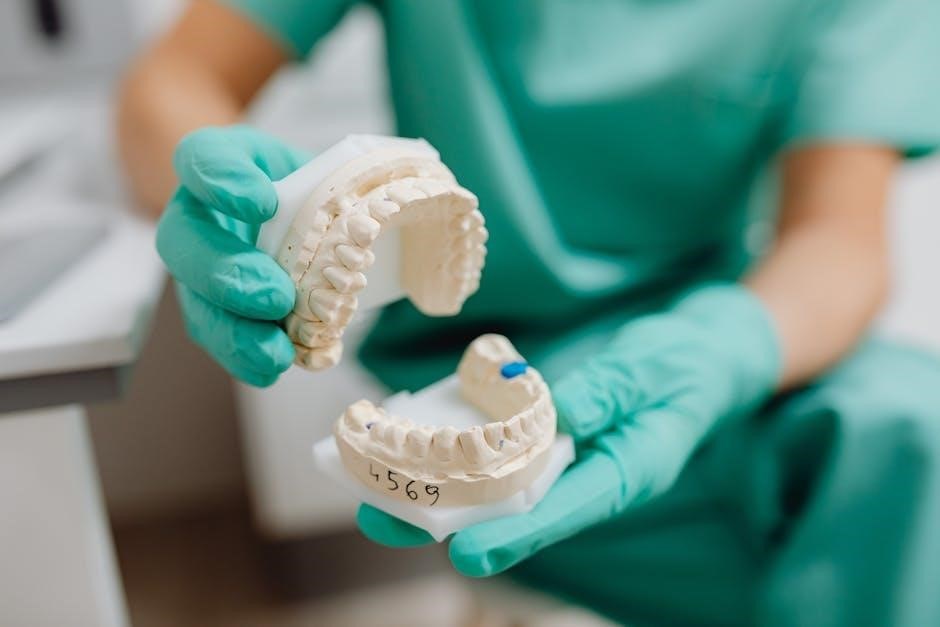
Role of the Dental Assistant During Setup
The dental assistant is crucial during setup, reviewing patient charts, preparing trays, and organizing instruments․ They ensure all necessary tools are sterilized, accessible, and ready for the procedure․
5․1 Pre-Procedure Preparation
Pre-procedure preparation involves the dental assistant reviewing patient charts, ensuring the operatory is ready, and organizing all necessary instruments and supplies․ This includes sterilizing equipment, preparing trays, and checking for any missing items․ The assistant must also confirm the procedure details with the dentist and patient, addressing any concerns․ Proper preparation ensures efficiency, safety, and a smooth workflow during the procedure․ Attention to detail is critical to avoid delays and maintain patient trust and comfort throughout the process․
5․2 Organizing Instruments for Efficiency
Organizing instruments for efficiency is crucial for smooth dental procedures․ Dental assistants should arrange tools in the order of use, ensuring easy access during treatment․ A preset tray system with clear plastic barriers helps maintain organization and infection control․ Essential instruments, such as periodontal probes and topical anesthetics, should be placed prominently․ The assistant must ensure all items are within reach, minimizing movement and saving time․ Proper organization enhances workflow, reduces distractions, and allows the dental team to focus on patient care, promoting efficiency and professionalism throughout the procedure․
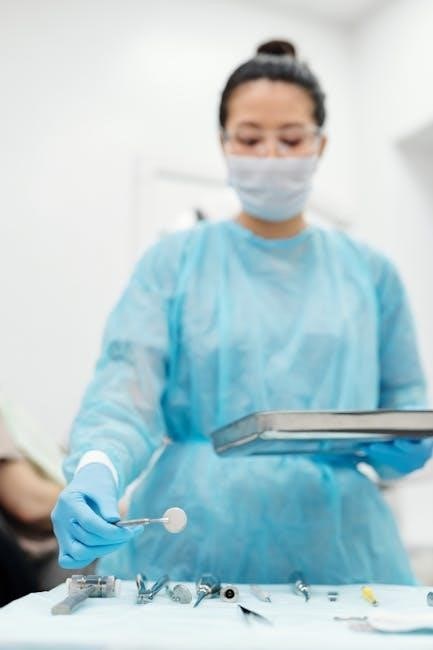
Patient Communication and Education
Effective communication is vital for patient comfort and understanding․ The dental assistant explains each procedure step clearly, addressing concerns and ensuring the patient feels informed and at ease․
6․1 Explaining the Procedure to the Patient
Clear communication is essential for patient understanding and trust․ The dental assistant explains the procedure step-by-step, using simple language and visual aids if needed․ This helps reduce anxiety and ensures the patient is informed about what to expect․ The assistant also addresses any questions or concerns, fostering a comfortable environment․ Effective communication ensures the patient feels prepared and cooperative throughout the process․ This step is crucial for building rapport and ensuring a smooth experience for both the patient and the dental team․
6․2 Addressing Patient Concerns
Addressing patient concerns is crucial for ensuring comfort and trust․ The dental assistant listens actively to the patient’s worries, providing empathetic and clear responses․ This includes discussing fears, previous experiences, or anxiety about the procedure․ The assistant offers reassurance and explains how the setup and process are designed for their safety and comfort․ By addressing concerns, the dental team creates a positive experience, helping the patient feel informed and at ease․ Open communication fosters a supportive environment, making the patient more cooperative and confident in the care they receive․
Post-Procedure Tray Management

Troubleshooting Common Setup Issues
Identify missing instruments and resolve promptly to avoid delays․ Adjust setups for special cases, such as pediatric or orthodontic procedures, ensuring efficiency and patient safety always․
7․1 Cleaning and Disinfecting the Tray
Cleaning and disinfecting the tray is crucial after each procedure to maintain hygiene and prevent cross-contamination․ Immediately remove any debris or materials․ Use gloves to handle soiled trays․ Apply a disinfectant specifically designed for dental equipment, ensuring all surfaces are covered․ Allow the solution to sit for the recommended time before rinsing thoroughly with water․ Dry the tray with a clean, lint-free cloth to prevent water spots․ Store the tray in a clean, dry area, ready for future use․ Proper cleaning ensures compliance with infection control standards and prolongs the life of the tray․
7․2 Storing Instruments After Use
After cleaning and disinfecting, instruments must be stored properly to maintain their condition and ensure readiness for future use․ Place instruments in a clean, dry environment, away from direct sunlight․ Use protective covers or pouches to prevent damage and contamination․ Separate sterile and non-sterile items clearly․ Label storage areas for easy identification․ Regularly inspect instruments for wear or damage and replace them as needed․ Proper storage extends the lifespan of dental tools and supports efficient setup for upcoming procedures․ Always follow manufacturer guidelines for specific storage requirements․
Common setup issues include missing instruments or supplies, incorrect arrangement, or contamination․ Solve these by using checklists, verifying sterilization, and consulting senior staff for guidance․ Efficiency is key․
8․1 Missing Instruments or Supplies
Missing instruments or supplies can delay procedures and disrupt workflow․ Always double-check the tray before starting․ If items are missing, consult a checklist or inventory list․ Notify the dentist or team leader immediately to locate or replace the items․ Consider maintaining a backup supply of essential tools․ Document the issue to prevent future occurrences․ Ensure all instruments are accounted for post-procedure to avoid recurrence․ This proactive approach ensures efficiency and reduces downtime during patient care․
8․2 Adjusting Setup for Special Cases
Special cases may require modifications to the standard tray setup․ For example, patients with disabilities or specific medical conditions may need additional tools or a customized layout․ Always review patient records beforehand to anticipate needs․ Immunocompromised patients may require enhanced infection control measures, such as reinforced barriers․ The dental assistant should coordinate with the dentist to ensure all necessary adjustments are made․ This might include adding specialized instruments or reorganizing the tray for easier access․ Proper preparation ensures safe and efficient care for all patients, regardless of their unique requirements․
